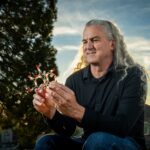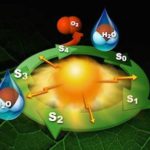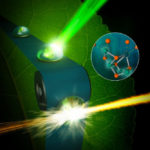Experimentation abounds for computational research scientist Nigel Moriarty. A lifelong stamp collector and surfer, Moriarty approaches culturally-distinct pockets of society with the curiosity of an anthropologist. And applying quantum chemistry and theoretical physics to drug design is part of his day-to-day work writing software with MBIB’s PHENIX group.
Researchers Capture Elusive Missing Step in Photosynthesis
After decades of effort, scientists have revealed atomic-scale details of the water splitting step of photosynthesis, the chemical process that generates the air we breathe. The latest work adds to our understanding of photosynthesis and will aid the development of fully renewable alternative energy sources.
Chloro-phylling in the Answers to Big Questions
A team of scientists, including many in the Molecular Biophysics and Integrated Bioimaging Division, uncovered new details about the reaction that powers photosynthesis. Understanding this reaction could lead to world-changing advances in technology, medicine, or energy––and also gives insight into how the enzyme photosystem II produces the oxygen we breathe. Their latest work was recently published in Nature Communications and two of the authors, Vittal Yachandra and Philipp Simon, spoke with Strategic Communications about that, shooting stuff with lasers, and why they chose this field of research.
Congratulations to Biosciences Area Director’s Award Recipients
Numerous Biosciences Area personnel are among the 2021 Berkeley Lab Director’s Awards honorees. This annual program recognizes outstanding contributions by employees to all facets of Lab activities. A complete list of winners can be found here. The 10th annual Director’s Awards ceremony will take place on November 18 at noon.
X-rays Capture Unprecedented Images of Photosynthesis in Action
An international team of scientists is getting closer to discovering how plants split water during photosynthesis and produce nearly all of the oxygen in our atmosphere. Thanks to unprecedented, atomic-scale images of a protein complex found in plants, algae, and cyanobacteria captured by ultrafast X-ray lasers, researchers conducted atomic-level experiments to help delineate the mechanism of this system that also yields the protons and electrons used to reduce carbon dioxide to carbohydrates later in the photosynthesis cycle. The effort to uncover the secrets of this protein complex, photosystem II, was led by Vittal Yachandra and Junko Yano in the Molecular Biophysics & Integrated Bioimaging (MBIB) Division and the team’s findings were published this week in Nature.
Was this page useful?








